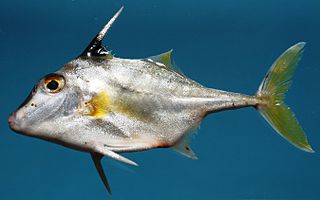
Tetraodontiformes, also known as the Plectognathi, is an order of ray-finned fishes which includes the pufferfishes and related taxa. This order has been classified as a suborder of the order Perciformes, although recent studies have found that it, as the Tetraodontoidei, is a sister taxon to the anglerfish order Lophiiformes, called Lophiodei, and have placed both taxa within the Acanthuriformes. The Tetraodontiformes are represented by 10 extant families and at around 430 species overall. The majority of the species within this order are marine but a few may be found in freshwater. They are found throughout the world.

The spikefishes are ray-finned fishes related to the pufferfishes and triggerfishes. They live in deep waters; more than 50 m (160 ft), but above the continental shelves. They are found in the Atlantic, Indian Ocean, and the west-central Pacific.

Pseudotriacanthus is a monospecific genus of marine ray-finned fish belonging to the family Triacanthidae, the triplespines or tripodfishes. The only species in this genus is Pseudotriacanthus strigilifer, the longspined tripodfish. This taxon is found in the Indo-West Pacific region.

Triacanthus is a genus of marine ray-finned fish belonging to the family Triacanthidae, the triplespines or tripodfishes. The two species in this genus are found in the Indian Ocean and the western Pacific Ocean.

Tripodichthys is a genus of marine ray-finned fish belonging to the family Triacanthidae, the triplespines or tripodfishes. The three species in this genus are found in the Indian Ocean and the western Pacific Ocean in shallow water over soft substrates.
Trixiphichthys, is a monospecific genus of marine ray-finned fish belonging to the family Triacanthidae, the triplespines or tripodfishes. The only species in this genus is Trixiphichthys weberi, the blacktip tripodfish or longnosed tripodfish. This taxon is found in the Indo-West Pacific region.
Bathyphylax is a genus of marine ray-finned fishes belonging to the family Triacanthodidae, the spikefishes. The fishes in this genus are found in the deep waters of the Indian and Pacific Oceans.

Halimochirurgus is a genus of marine ray-finned fishes belonging to the family Triacanthodidae, the spikefishes. The fishes in this genus are found in the deep waters of the Indian and Pacific Oceans.
Johnsonina is a monospecific genus of marine ray-finned fish belonging to the family Triacanthodidae, the spikefishes. The only species in the genus is Johnsonina eriomma, the bullseye spikefish, which is found in the Western Atlantic Ocean.
Mephisto fraserbrunneri, the devil's spikefish, is a species of marine ray-finned fish belonging to the family Triacanthodidae, the spikefishes. This species is found in the Indian Ocean.
Mephisto is a genus of marine ray-finned fishes belonging to the family Triacanthodidae, the spikefishes. These fishes are found in the Indian Ocean.

Paratriacanthodes is a genus of marine ray-finned fishes belonging to the family Triacanthodidae, the spikefishes. These fishes are found found in the Indian and Pacific Oceans.

Triacanthodes is a genus of marine ray-finned fishes belonging to the family Triacanthodidae, the spikefishes. These fishes are found found in the Indian and Pacific Oceans.
Tydemania navigatoris, the fleshy-lipped spikefish, is a species of marine ray-finned fish belonging to the family Triacanthodidae, the spikefishes. This species is found in the Indian and Pacific Oceans where it occurs at depths of from 50 to 607 metres. This species grows to a length of 12 centimetres (4.7 in) SL. This fish is specialized to feed on the scales of other fishes. This species is the only known member of the genus Tydemania.

Triacanthus biaculeatus, also known as the short-nosed tripod fish, black-finned triple-spine, blacktail tripodfish, hollow-snouted tripodfish or silver tripodfish, is a species of marine ray-finned fish belonging to the family Triacanthidae, the triplespines or tripodfishes. This species is found in the Indo-West Pacific region.

Triacanthodes ethiops, the shortsnout spikefish, is a species of marine ray-finned fish belonging to the family Triacanthodidae, the spikefishes. This species is found in the Northwestern Pacific Ocean.

Paratriacanthodes retrospinis, the sawspine spikefish, is a species of marine ray-finned fish belonging to the family Triacanthodidae, the spikefishes. This species is found in the Indo-Pacific region.

Triacanthodes anomalus, the red spikefish, is a species of marine ray-finned fish belonging to the family Triacanthodidae, the spikefishes. This species is found in the Northwestern Pacific Ocean.

Triacanthodinae is a subfamily of marine ray-finned fishes belonging to the family Triacanthodidae, the spikefishes. This subfamily comprises nine genera and a total of nineteen species and all, except one species, are found in the tropical and subtropical waters of the Indo-Pacific. The exception is found in the western Atlantic Ocean.
Mephisto albomaculosus, the white spotted spikefish, is a species of marine ray-finned fish belonging to the family Triacanthodidae, the spikefishes. This species is found in the Indian Ocean.










